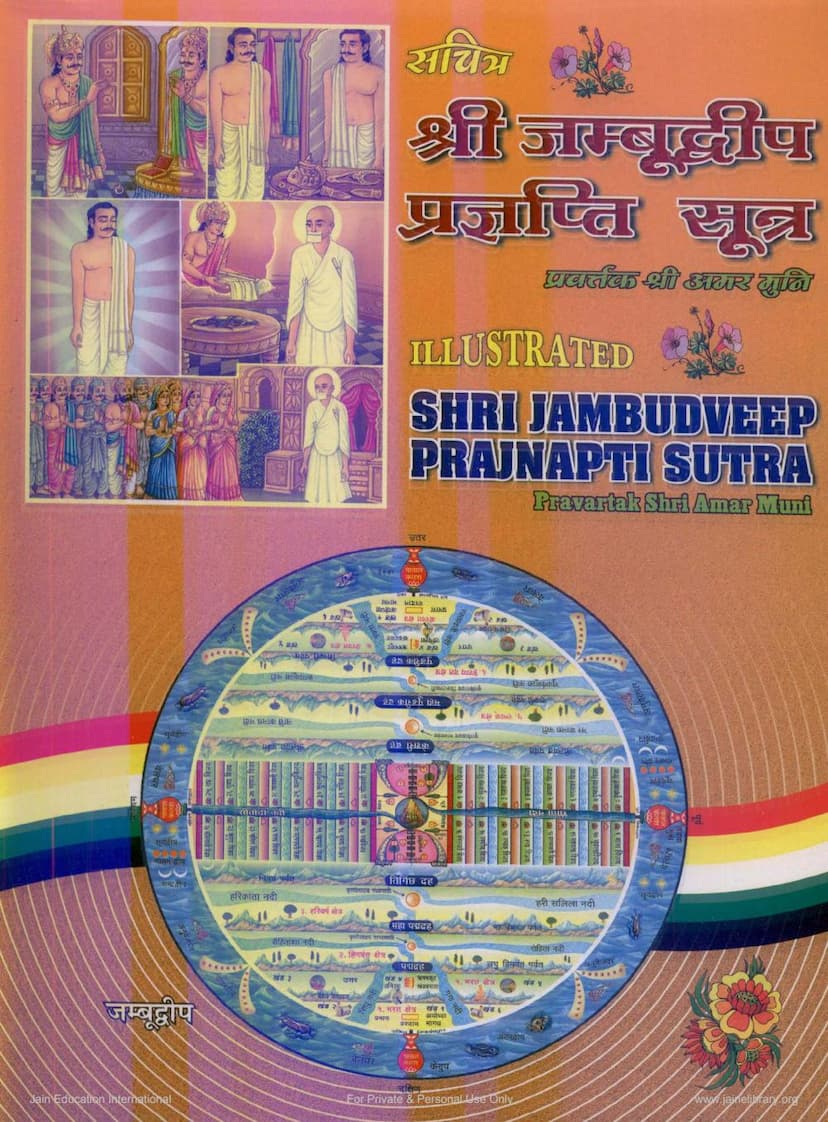Agam 18 Upang 07 Jambudveep Pragnapti Sutra Sthanakvasi
Added to library: September 1, 2025

Summary
The provided text is a Jain scripture titled Jambudveep Prajnapti Sutra, specifically Agam 18, Upang 07. Authored by Amarmuni and Shreechand Surana, and published by Padma Prakashan, it is described as an illustrated edition with Hindi and English translations.
Here's a comprehensive summary of the key aspects presented in the text:
Overall Significance:
- Compendium of Jain Culture and History: The book is recognized as a valuable source of knowledge about Jain culture and history.
- Crucial Jain Geography: It holds significant importance from the perspective of Jain geography, offering detailed insights into the structure of the universe as understood in Jainism.
- Lesser-Known Information: A careful study of this scripture is said to reveal important but less-known details about Jain culture.
- Spiritual Importance: The book holds unique importance in the spiritual realm, with its geographical descriptions serving as a fulcrum for concern for the living world.
Central Theme: Jambudveep:
- Detailed Description: The primary focus is the detailed description of Jambudveep, the central continent situated amidst all islands and oceans.
- Size and Shape: Jambudveep is described as circular, like a wheel, or a full moon, or a flat plate with a rim. Its expanse is one hundred thousand yojanas (a unit of measurement) in length and breadth. The text also notes a potential discrepancy between this description and modern scientific understanding of the Earth's shape, offering interpretations from Jain scholars to reconcile this.
- Geographical Features: The scripture meticulously details various geographical features within Jambudveep, including:
- Human Habitats (Areas): Bharat, Haimavat, Harivarsh, Mahavideh, Uttar Kuru, Ramyak, Hairanyavat, and Airavat regions are described.
- Mountains: Numerous mountains are mentioned, including Meru Parvat, Chull Himavan, Maha Himavan, Vaitadhya, Nishadh, Gandhamadan, Yamak, Kanchanagiri, Malyavant, Neelavant, Rukmi, and Shikhar.
- Rivers: Significant rivers like Ganga, Sindhu, Sita, Shitoda, Rupyakula, Suvarnakula, Raktavati, and Rakta are described.
- Other Structures: Walls (Jagati), gates (Vijay, Vaijayant, Jayant, Aparajit), gardens, residential areas, palaces, and divine vehicles are also mentioned.
Key Content Areas (Divided into Seven Chapters - Vakshaskars):
- Introduction to Jambudveep: General geographical description of Jambudveep.
- Time Cycle (Kalachakra): Detailed explanation of the Avasarpini (regressive time cycle) and Utsarpini (progressive time cycle). This includes:
- Six Aeons (Aaras): Descriptions of the six stages of time, from Sukhama-Sukhama (great happiness) to Dukham-Dukhama (great sorrow), and vice-versa for Utsarpini.
- Environmental Impact: The text elaborates on how environmental changes during these aeons affected human life, their behavior, food, and lifespan, drawing parallels to contemporary environmental concerns.
- First Tirthankar Rishabhdev: The complete life story of Bhagavan Rishabhdev, from his birth, renunciation, attainment of omniscience, to his liberation (parinirvan), is presented in detail. This includes the rituals performed by celestial beings during his birth and death.
- Emperor Bharat: The life of Emperor Bharat is described, including his conquest of the six divisions of Bharat Kshetra, his wealth, and his eventual renunciation and spiritual realization. The text details the elaborate coronation ceremony and the significance of the Fourteen Jewels (Ratnas) and Nine Treasures (Nidhis) that accompanied his reign.
- Conquests and Administration: This chapter focuses on Emperor Bharat's military campaigns, including his victories over various regions like the Kirats, his journey to Magadh Tirth, Prabhas Tirth, Tamisra Cave, and his subsequent marriage to Subhadra. It also details his administrative reforms and the establishment of a twelve-year festival of joy.
- Cosmology and Jyotish (Astrology): Information about the stellar cycles, the movement of the sun, moon, planets, and constellations, and their relation to the divisions of time like days, months, and years.
Illustrations and Translation:
- Illustrated Edition: The book is noted for its beautiful colored illustrations, created from ancient palm-leaf manuscripts. These visuals are intended to help readers understand complex geographical concepts and incidents from the lives of Bhagavan Rishabhdev and Bharat Chakravarti.
- Hindi-English Translation: A simple English translation is provided alongside the original Prakrit text, making the knowledge accessible to a wider audience, including those residing abroad who may not be fluent in Hindi.
Target Audience and Research Value:
- For Curious Readers: The scripture is highly recommended for readers eager to learn about Jain geography.
- Research Work: It is considered a valuable reference book for researchers in the field of Jainism.
- Spiritual Contemplation: Reading this book with faith and concentration can aid in contemplating the 'Lok Bhavna' (the feeling or contemplation of the world).
In essence, the Jambudveep Prajnapti Sutra is a foundational Jain text that provides a comprehensive cosmological and geographical framework within the Jain tradition. It intertwines detailed descriptions of the universe with the lives of key historical figures like Lord Rishabhdev and Emperor Bharat, offering a rich tapestry of Jain culture, history, and spiritual understanding.